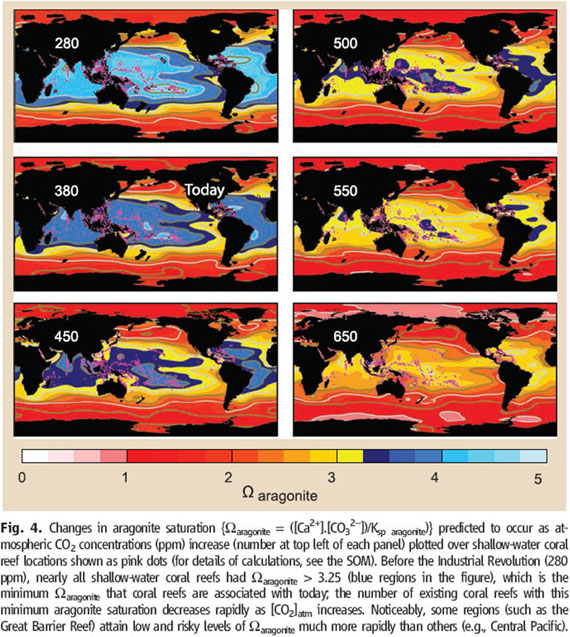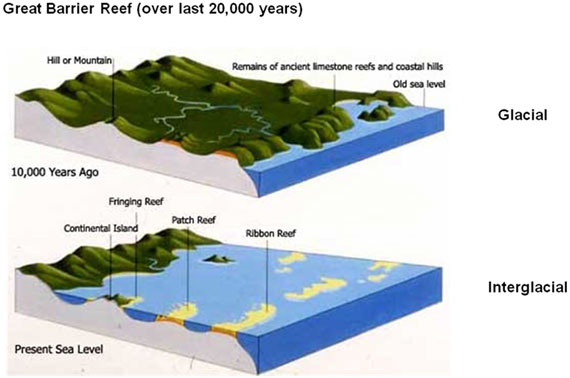
Dr. Ove Hoegh-Guldberg is a Professor of Marine Studies and Director of the Global Change Institute at the University of Queensland, and one of the foremost experts on the Great Barrier Reef (GBR). This is the third and final part in the series from Dr. Hoegh-Guldberg on the state of the GBR (following up on Part 1 and Part 2).
Coral reefs are susceptible to the impacts of ocean acidification (Raven et al. 2005). Ocean acidification arises from increased amounts of CO2 entering the world's oceans. CO2 reacts with water to create a dilute acid (carbonic acid), which interacts with other chemical species present in sea water such as carbonate ions. In the latter case, carbonate ions are increasingly turned into bicarbonate ions. The two changes brought about by ocean acidification, decreasing pH, and carbonate ion concentrations, impact a wide range of marine organisms (Hendriks et al. 2009; Kleypas and Langdon 2006; Kleypas et al. 2006). There is now a large amount of information showing that reef building corals are susceptible to relatively small changes in ocean acidification (Kleypas and Langdon 2006), probably as a result of declining carbonate ion concentrations in the first instance. An important point is that warming sea temperatures and steadily acidifying oceans interact in terms of their impact on reef building corals. That is, the thermal sensitivity of corals appears to increase as oceans become increasingly acidic (Anthony et al. 2008). The full implications of this interaction between climate change stressors has not been fully explored to date.
There is now very strong evidence that the Great Barrier Reef is being affected by the combination of these two stress factors. In a study of 328 long-lived corals from a full range of habitats on the Great Barrier Reef has revealed that calcification rates have fallen by 15% since 1990, which is unprecedented in the 400 years of coral core records examined (De'ath et al. 2009). Similar results have also been found in a number of sites around the world (Tanzil et al. 2009). While it is not possible to attribute this change to either increasing tropical sea temperatures or ocean acidification on their own, this study does reveal that changes to the conditions within the Coral Sea (which is steadily rising in sea temperature and acidity) are driving some exceptional changes to fundamental reef processes like calcification.
Other evidence of the importance of these two factors comes from our current understanding of what limits the growth and distribution of coral reefs worldwide. The current distribution of carbonate coral reefs around the world today is associated with concentrations of carbonate ions of 200 µmol per kilogram water or more. In this case, there is a natural gradient towards reduced carbonate ion concentrations and more acidic oceans at higher latitudes. This is primarily due to the fact that cold water can contain a lot more carbon dioxide.
The significance of this threshold for carbonate ions is that these are the concentrations that you get in tropical oceans when carbon dioxide increases above 450 ppm. Given that these levels of carbon dioxide in the atmosphere are likely to be associated with at least a 2°C increase in sea temperature, it appears that coral reefs will largely disappear if atmospheric concentrations of carbon dioxide exceed 450 ppm. The full background to this argument can be found in the following review paper in Science magazine: (Hoegh-Guldberg et al. 2007). In terms of the distribution of waters that will have the right chemistry for carbonate coral reef ecosystems, the following set of diagrams from this paper outlines how these change as atmospheric levels of CO2 increase (number in top left hand side of each panel). The blue water in these diagrams is essentially that required for carbonate reef ecosystems (which are represented by the pink dots).

Figure 1. Changes in ocean chemistry is a function of atmospheric CO2 concentration. See Hoegh-Guldberg et al. (2007) for further details.
The Great Barrier Reef has undergone major transformations in the geological past. During the glacial periods when large amounts of water have been locked up in glaciers and landlocked ice masses, sea levels were over 100 m lower than they are today. This meant that the Great Barrier Reef lagoon was completely exposed and was a wooded grassland not too dissimilar to those found in Queensland today. All of the islands and reef structures that remained after the water retreated were covered with soil and were unrecognisable as coral reefs.
This has prompted some to ask: Why are we so worried about climate change today if the Great Barrier Reef has undergone these types of changes in the past?
The answer to this question is straightforward and comes down to the issue of the rate of change. The changes in temperature and sea level associated with glacial cycles occurred over 10-20,000 years. In this period of time, global temperatures changed by 5-8 degrees Celsius and atmospheric concentrations of carbon dioxide by 100 ppm. If we compare these sets of changes to that going on today, we see that we are undergoing similar set of changes only we are undertaking them in less than 100 years. That essentially means that the rate of change today is about 100-200 times faster than in the past.

Figure 2. Changes in the Great Barrier Reef and Queensland coastline between glacial and interglacial periods. During last glacial period, sea levels were 100 m lower than they are today, exposing a large part of the Great Barrier Reef which subsequently covered by grasslands and forests.
While some changes in the past were relatively rapid, animals and plants like those associated with the Great Barrier Reef had time to shift their geographic distribution as the environments changed. Today, there are clear signs that the speed of change is exceeding the ability of organisms and ecosystems to shift. The Great Barrier Reef provides an instructive example of how fast reef ecosystems need to migrate if they were to keep pace with changing climate. Corals at the northern end are adapted to warmer temperatures (about 3°C) than those in the southern part of the Great Barrier Reef. If corals were to move southward at a rate which matched an increase in sea temperature of 3°C by 2100, they would necessarily have to travel the entire length of the Great Barrier Reef (2500 km) within approximately 100 years. That means that reef ecosystems would have to travel at the rate of 25 km per year. There is very little evidence that complex ecosystems such as the Great Barrier Reef would be able to travel at this impossibly high rate of movement of the environmental conditions necessary for Coral Reef development.
The final point that needs to be made with respect to the question of why we are worried today if coral reefs of undergone big changes in the past is that of timescale. When coral reefs have experience calamities in the past, they have been absent for very long periods (i.e. millions of years). These timescales are well beyond those that make any sense with respect to humans and their dependence on the ecological services provided by coral reefs.
Putting it bluntly, it is irrelevant that reefs have bounced back in geological time when the timescale of importance for the people depend on coral reefs (such as our vibrant tourist industry here in Australia, or the millions of people around the world need them for their food) is on a month to year basis.
References:
Anthony, K. R., D. I. Kline, G. Diaz-Pulido, S. Dove, and O. Hoegh-Guldberg, 2008: Ocean acidification causes bleaching and productivity loss in coral reef builders. Proc Natl Acad Sci U S A, 105, 17442-17446.
De'ath, G., J. M. Lough, and K. E. Fabricius, 2009: Declining Coral Calcification on the Great Barrier Reef. Science, 323, 116-119.
Hendriks, I., C. Duarte, and M. Álvarez, 2009: Vulnerability of marine biodiversity to ocean acidification: A meta-analysis. Estuarine, Coastal and Shelf Science.
Hoegh-Guldberg, O., and Coauthors, 2007: Coral reefs under rapid climate change and ocean acidification. Science, 318, 1737-1742.
Kleypas, J. A., and C. Langdon, 2006: Coral reefs and changing seawater chemistry, Chapter 5 Coral Reefs and Climate Change: Science and Management. AGU Monograph Series, Coastal and Estuarine Studies, J. Phinney, O. Hoegh-Guldberg, J. Kleypas, W. Skirving, and A. E. Strong, Eds., Geophys. Union, 73-110.
Kleypas, J. A., R. A. Feely, V. J. Fabry, C. Langdon, C. L. Sabine, and R. R. Robbins, 2006: Impacts of ocean acidification on coral reefs and other marine calcifiers: A guide for future research, Report of a workshop held 18-20 April 2005, St Petersburg, FL, sponsored by NSF, NOAA and the US Geological Survey, 88pp.
Raven, J., and Coauthors, 2005: Ocean acidification due to increasing atmospheric carbon dioxide.
Tanzil, J., B. Brown, A. Tudhope, and R. Dunne, 2009: Decline in skeletal growth of the coral Porites lutea from the Andaman Sea, South Thailand between 1984 and 2005. Coral Reefs, DOI 10.1007/s00338-008-0457-5.
This series has been made into the Advanced Rebuttal to "Great Barrier Reef is in good shape"
Posted by Ove Hoegh-Guldberg on Thursday, 14 July, 2011
 |
The Skeptical Science website by Skeptical Science is licensed under a Creative Commons Attribution 3.0 Unported License. |